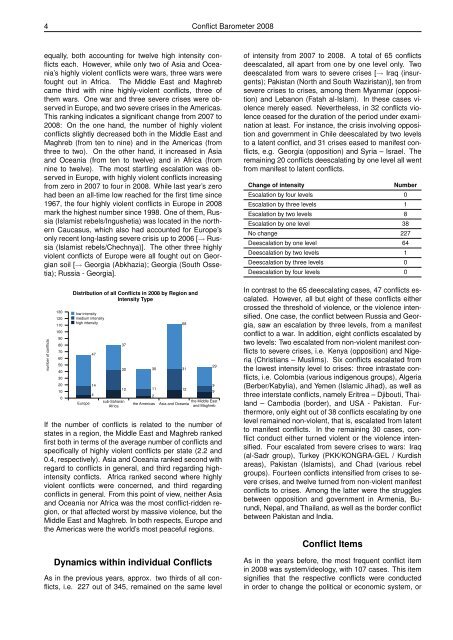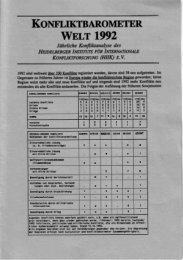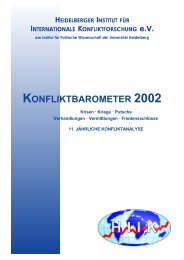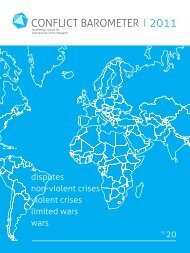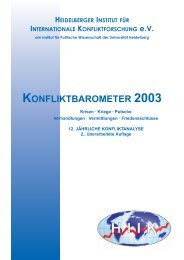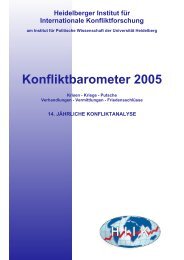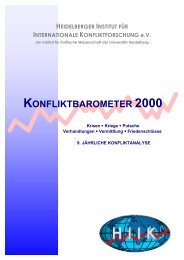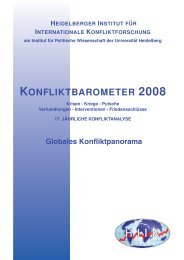CONFLICT BAROMETER 2008
CONFLICT BAROMETER 2008
CONFLICT BAROMETER 2008
Create successful ePaper yourself
Turn your PDF publications into a flip-book with our unique Google optimized e-Paper software.
4 Conflict Barometer <strong>2008</strong><br />
equally, both accounting for twelve high intensity conflicts<br />
each. However, while only two of Asia and Oceania’s<br />
highly violent conflicts were wars, three wars were<br />
fought out in Africa. The Middle East and Maghreb<br />
came third with nine highly-violent conflicts, three of<br />
them wars. One war and three severe crises were observed<br />
in Europe, and two severe crises in the Americas.<br />
This ranking indicates a significant change from 2007 to<br />
<strong>2008</strong>: On the one hand, the number of highly violent<br />
conflicts slightly decreased both in the Middle East and<br />
Maghreb (from ten to nine) and in the Americas (from<br />
three to two). On the other hand, it increased in Asia<br />
and Oceania (from ten to twelve) and in Africa (from<br />
nine to twelve). The most startling escalation was observed<br />
in Europe, with highly violent conflicts increasing<br />
from zero in 2007 to four in <strong>2008</strong>. While last year’s zero<br />
had been an all-time low reached for the first time since<br />
1967, the four highly violent conflicts in Europe in <strong>2008</strong><br />
mark the highest number since 1998. One of them, Russia<br />
(Islamist rebels/Ingushetia) was located in the northern<br />
Caucasus, which also had accounted for Europe’s<br />
only recent long-lasting severe crisis up to 2006 [→ Russia<br />
(Islamist rebels/Chechnya)]. The other three highly<br />
violent conflicts of Europe were all fought out on Georgian<br />
soil [→ Georgia (Abkhazia); Georgia (South Ossetia);<br />
Russia - Georgia].<br />
number of conflicts<br />
130<br />
120<br />
110<br />
100<br />
90<br />
80<br />
70<br />
60<br />
50<br />
40<br />
30<br />
20<br />
10<br />
0<br />
Distribution of all Conflicts in <strong>2008</strong> by Region and<br />
Intensity Type<br />
low intensity<br />
medium intensity<br />
high intensity<br />
Europe<br />
47<br />
14<br />
4<br />
37<br />
30<br />
12<br />
sub-Saharan<br />
Africa<br />
30<br />
11<br />
2<br />
the Americas<br />
68<br />
31<br />
12<br />
Asia and Oceania<br />
29<br />
9<br />
9<br />
the Middle East<br />
and Maghreb<br />
If the number of conflicts is related to the number of<br />
states in a region, the Middle East and Maghreb ranked<br />
first both in terms of the average number of conflicts and<br />
specifically of highly violent conflicts per state (2.2 and<br />
0.4, respectively). Asia and Oceania ranked second with<br />
regard to conflicts in general, and third regarding highintensity<br />
conflicts. Africa ranked second where highly<br />
violent conflicts were concerned, and third regarding<br />
conflicts in general. From this point of view, neither Asia<br />
and Oceania nor Africa was the most conflict-ridden region,<br />
or that affected worst by massive violence, but the<br />
Middle East and Maghreb. In both respects, Europe and<br />
the Americas were the world’s most peaceful regions.<br />
Dynamics within individual Conflicts<br />
As in the previous years, approx. two thirds of all conflicts,<br />
i.e. 227 out of 345, remained on the same level<br />
of intensity from 2007 to <strong>2008</strong>. A total of 65 conflicts<br />
deescalated, all apart from one by one level only. Two<br />
deescalated from wars to severe crises [→ Iraq (insurgents);<br />
Pakistan (North and South Waziristan)], ten from<br />
severe crises to crises, among them Myanmar (opposition)<br />
and Lebanon (Fatah al-Islam). In these cases violence<br />
merely eased. Nevertheless, in 32 conflicts violence<br />
ceased for the duration of the period under examination<br />
at least. For instance, the crisis involving opposition<br />
and government in Chile deescalated by two levels<br />
to a latent conflict, and 31 crises eased to manifest conflicts,<br />
e.g. Georgia (opposition) and Syria – Israel. The<br />
remaining 20 conflicts deescalating by one level all went<br />
from manifest to latent conflicts.<br />
Change of intensity<br />
Number<br />
Escalation by four levels 0<br />
Escalation by three levels 1<br />
Escalation by two levels 8<br />
Escalation by one level 38<br />
No change 227<br />
Deescalation by one level 64<br />
Deescalation by two levels 1<br />
Deescalation by three levels 0<br />
Deescalation by four levels 0<br />
In contrast to the 65 deescalating cases, 47 conflicts escalated.<br />
However, all but eight of these conflicts either<br />
crossed the threshold of violence, or the violence intensified.<br />
One case, the conflict between Russia and Georgia,<br />
saw an escalation by three levels, from a manifest<br />
conflict to a war. In addition, eight conflicts escalated by<br />
two levels: Two escalated from non-violent manifest conflicts<br />
to severe crises, i.e. Kenya (opposition) and Nigeria<br />
(Christians – Muslims). Six conflicts escalated from<br />
the lowest intensity level to crises: three intrastate conflicts,<br />
i.e. Colombia (various indigenous groups), Algeria<br />
(Berber/Kabylia), and Yemen (Islamic Jihad), as well as<br />
three interstate conflicts, namely Eritrea – Djibouti, Thailand<br />
– Cambodia (border), and USA - Pakistan. Furthermore,<br />
only eight out of 38 conflicts escalating by one<br />
level remained non-violent, that is, escalated from latent<br />
to manifest conflicts. In the remaining 30 cases, conflict<br />
conduct either turned violent or the violence intensified.<br />
Four escalated from severe crises to wars: Iraq<br />
(al-Sadr group), Turkey (PKK/KONGRA-GEL / Kurdish<br />
areas), Pakistan (Islamists), and Chad (various rebel<br />
groups). Fourteen conflicts intensified from crises to severe<br />
crises, and twelve turned from non-violent manifest<br />
conflicts to crises. Among the latter were the struggles<br />
between opposition and government in Armenia, Burundi,<br />
Nepal, and Thailand, as well as the border conflict<br />
between Pakistan and India.<br />
Conflict Items<br />
As in the years before, the most frequent conflict item<br />
in <strong>2008</strong> was system/ideology, with 107 cases. This item<br />
signifies that the respective conflicts were conducted<br />
in order to change the political or economic system, or


